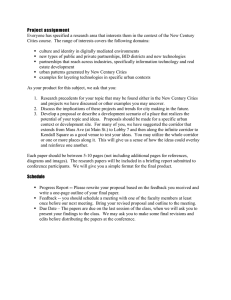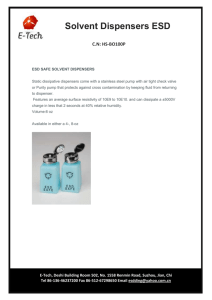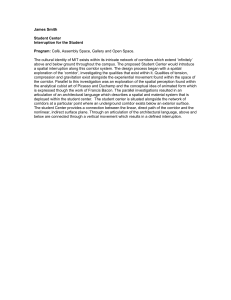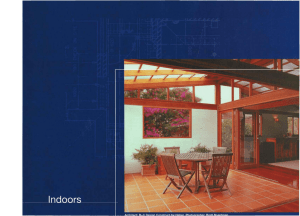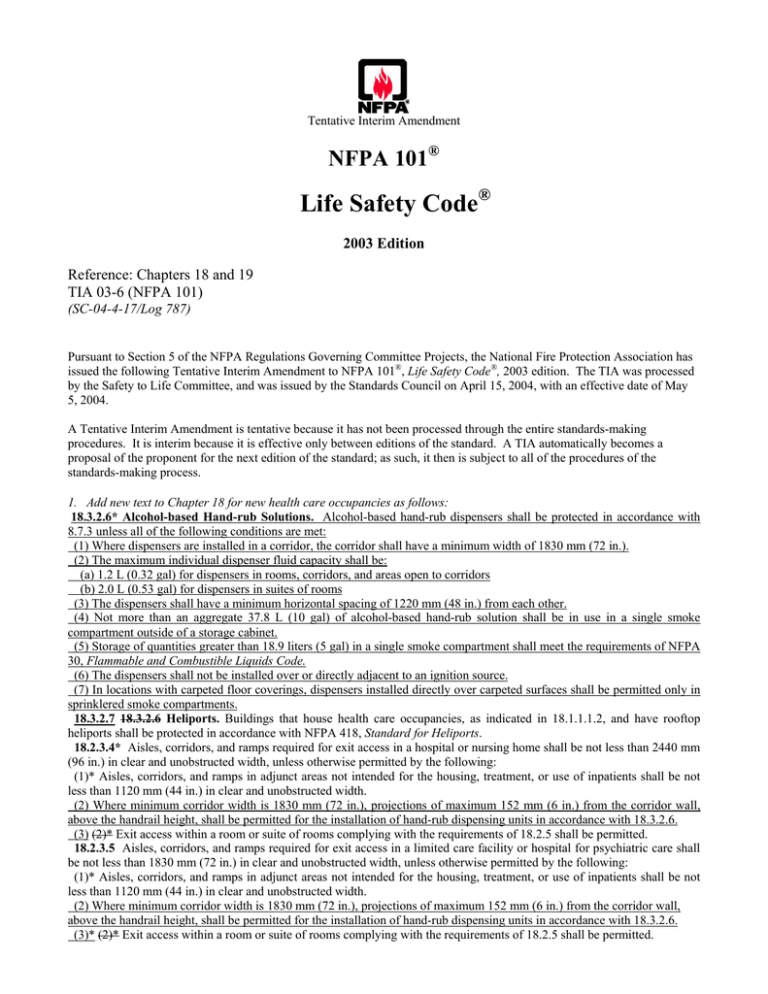
Tentative Interim Amendment
NFPA 101®
Life Safety Code®
2003 Edition
Reference: Chapters 18 and 19
TIA 03-6 (NFPA 101)
(SC-04-4-17/Log 787)
Pursuant to Section 5 of the NFPA Regulations Governing Committee Projects, the National Fire Protection Association has
issued the following Tentative Interim Amendment to NFPA 101®, Life Safety Code®, 2003 edition. The TIA was processed
by the Safety to Life Committee, and was issued by the Standards Council on April 15, 2004, with an effective date of May
5, 2004.
A Tentative Interim Amendment is tentative because it has not been processed through the entire standards-making
procedures. It is interim because it is effective only between editions of the standard. A TIA automatically becomes a
proposal of the proponent for the next edition of the standard; as such, it then is subject to all of the procedures of the
standards-making process.
1. Add new text to Chapter 18 for new health care occupancies as follows:
18.3.2.6* Alcohol-based Hand-rub Solutions. Alcohol-based hand-rub dispensers shall be protected in accordance with
8.7.3 unless all of the following conditions are met:
(1) Where dispensers are installed in a corridor, the corridor shall have a minimum width of 1830 mm (72 in.).
(2) The maximum individual dispenser fluid capacity shall be:
(a) 1.2 L (0.32 gal) for dispensers in rooms, corridors, and areas open to corridors
(b) 2.0 L (0.53 gal) for dispensers in suites of rooms
(3) The dispensers shall have a minimum horizontal spacing of 1220 mm (48 in.) from each other.
(4) Not more than an aggregate 37.8 L (10 gal) of alcohol-based hand-rub solution shall be in use in a single smoke
compartment outside of a storage cabinet.
(5) Storage of quantities greater than 18.9 liters (5 gal) in a single smoke compartment shall meet the requirements of NFPA
30, Flammable and Combustible Liquids Code.
(6) The dispensers shall not be installed over or directly adjacent to an ignition source.
(7) In locations with carpeted floor coverings, dispensers installed directly over carpeted surfaces shall be permitted only in
sprinklered smoke compartments.
18.3.2.7 18.3.2.6 Heliports. Buildings that house health care occupancies, as indicated in 18.1.1.1.2, and have rooftop
heliports shall be protected in accordance with NFPA 418, Standard for Heliports.
18.2.3.4* Aisles, corridors, and ramps required for exit access in a hospital or nursing home shall be not less than 2440 mm
(96 in.) in clear and unobstructed width, unless otherwise permitted by the following:
(1)* Aisles, corridors, and ramps in adjunct areas not intended for the housing, treatment, or use of inpatients shall be not
less than 1120 mm (44 in.) in clear and unobstructed width.
(2) Where minimum corridor width is 1830 mm (72 in.), projections of maximum 152 mm (6 in.) from the corridor wall,
above the handrail height, shall be permitted for the installation of hand-rub dispensing units in accordance with 18.3.2.6.
(3) (2)* Exit access within a room or suite of rooms complying with the requirements of 18.2.5 shall be permitted.
18.2.3.5 Aisles, corridors, and ramps required for exit access in a limited care facility or hospital for psychiatric care shall
be not less than 1830 mm (72 in.) in clear and unobstructed width, unless otherwise permitted by the following:
(1)* Aisles, corridors, and ramps in adjunct areas not intended for the housing, treatment, or use of inpatients shall be not
less than 1120 mm (44 in.) in clear and unobstructed width.
(2) Where minimum corridor width is 1830 mm (72 in.), projections of maximum 152 mm (6 in.) from the corridor wall,
above the handrail height, shall be permitted for the installation of hand-rub dispensing units in accordance with 18.3.2.6.
(3)* (2)* Exit access within a room or suite of rooms complying with the requirements of 18.2.5 shall be permitted.
A.18.3.2.6 The Centers for Disease Control and Prevention on October 25, 2002, issued the Guidelines for Hand Hygiene in
Health-Care Settings [MMWR 2002; 51 (no. RR-16)], which highly recommends the placement of alcohol-based hand-rub
solutions in convenient locations of patient care areas of health care organizations. Clinical studies indicate that the frequency
of handwashing or antiseptic handwashing by personnel is affected by the accessibility of hand-hygiene facilities. By
permitting the installation of hand-rub dispensers immediately outside the patient/residence bedroom or within suites of
rooms, the overall efficacy of staff use has been proven to increase by over 20 percent.
According to the CDC, more that 88,000 patient deaths per year are attributed to hospital-acquired infections, and one of the
principal methodologies for reducing this statistic is by the expanded use of alcohol-based hand-rub solutions. These products
have been found to be more effective for standard handwashing or hand antisepsis by health care workers than soap or
antimicrobial soaps.
To address the fire hazard of introducing additional alcohol-based materials, a fire-modeling project was initiated to study
the overall effects of placing dispensers in corridors and suites of rooms. This modeling was accomplished using the Fire
Dynamics Simulator (FDS) Version 3.1 published by the National Institute of Standards and Technology (NIST). Using the
results of the FDS, model the potential hazards were evaluated by reviewing the data for tenability of the space, ignition of
adjacent fuel loads/combustibles, and sprinkler activation.
The tenability value for this report was chosen to be conservative. The fire modeling does clearly show that up to (1.2-L)
0.32-gal container size in a corridor and up to a (2-L) 0.53-gal container size in a suite location to be acceptable for either
Ethyl; or Isopropyl Alcohol-based products. Except for a scenario that modeled the (1.2-L) 0.32-gal Isopropyl Alcohol
container in a 1830 mm (72 in.) wide corridor with all doors closed, all of the results with realistic conditions showed no
issues. For that one scenario, the visibility did drop below the stated threshold, but since visibility is not an immediate health
concern and it did not occur until the very end of the fire's burn time (final 15 seconds), only to improve dramatically to twice
the allowable value, we feel that this is still an acceptable result. The scenario with 1830 mm (72 in.) corridors and all doors
closed, which is a very extreme case compared to actual conditions, does show some concerns compared to our tenability
criteria. The results showed that the corridor remained below the visibility and CO thresholds established. The temperature in
this scenario did drop below the tenability threshold (which has a factor of safety of 10) but not significantly. This scenario
helps to prove that the hazard is acceptable.
The results clearly indicate that the (2-L) 0.53-gal container size to be unacceptable in a corridor location. In addition, the
results also indicate the scenario with a carpeted floor is a concern due to visibility problems. The scenario showed that the
visibility in the corridor dropped slightly below our assigned threshold. The carpet scenario is based on assumptions (soot
and CO yields) that are not validated via any test data or other available data sources. The yields used are based on
engineering judgment and need further study to make a firm recommendation.
Visibility, unlike other tenability areas (for example, temperature, toxicity), is based on a number of factors, has limited real
life test data, and is very subjective. The resources available have a wide range of values that could be considered acceptable
based on various factors, such as type of smoke (irritating vs. non-irritating), travel distances, familiarity with escape routes,
etc.
The results showed that none of the fuel targets put into the models would ignite based on the design fires chosen. This
indicates the proposed spacing to be reasonable to prevent additional fire hazards. Sprinkler activation was not predicted for
most of the scenarios modeled. When the sprinklers actuated it was most often after the conditions had exceeded the
tenability thresholds and typically with the larger (2-L) 0.53-gal spills. Due to the lack of sprinkler activation, it is important
to address the hazard from products of combustion such as smoke or CO more than the hazards from heat or the actual fire.
2. Add new text to Chapter 19 for existing health care occupancies as follows:
19.3.2.6* Alcohol-based Hand-rub Solutions. Alcohol-based hand-rub dispensers shall be protected in accordance with
8.7.3 unless all of the following conditions are met:
(1) Where dispensers are installed in a corridor, the corridor shall have a minimum width of 1830 mm (72 in.).
(2) The maximum individual dispenser fluid capacity shall be:
(a) 1.2 L (0.32 gal) for dispensers in rooms, corridors, and areas open to corridors
(b) 2.0 L(0.53 gal) for dispensers in suites of rooms
(3) The dispensers shall have a minimum horizontal spacing of 1220 mm (48 in.) from each other.
(4) Not more than an aggregate 37.8 L(10 gal) of alcohol-based hand-rub solution shall be in use in a single smoke
compartment outside of a storage cabinet.
(5) Storage of quantities greater than 18.9 L (5 gal) in a single smoke compartment shall meet the requirements of NFPA 30,
Flammable and Combustible Liquids Code.
(6) The dispensers shall not be installed over or directly adjacent to an ignition source.
(7) In locations with carpeted floor coverings, dispensers installed directly over carpeted surfaces shall be permitted only in
sprinklered smoke compartments.
19.2.3.4* Any required aisle, corridor, or ramp shall be not less than 1220 mm (48 in.) in clear width where serving as
means of egress from patient sleeping rooms, unless otherwise permitted by the following:
(1) Aisles, corridors, and ramps in adjunct areas not intended for the housing, treatment, or use of inpatients shall be not less
than 1120 mm (44 in.) in clear and unobstructed width.
(2) Where minimum corridor width is 1830 mm (72 in.), projections of maximum 152 mm (6 in.) from the corridor wall,
above the handrail height, shall be permitted for the installation of hand-rub dispensing units in accordance with 19.3.2.6.
(3) (2) Exit access within a room or suite of rooms complying with the requirements of 19.2.5 shall be permitted.
A.19.3.2.6 The Centers for Disease Control and Prevention on October 25, 2002, issued the Guidelines for Hand Hygiene in
Health-Care Settings [MMWR 2002; 51 (no. RR-16)], which highly recommends the placement of alcohol-based hand-rub
solutions in convenient locations of patient care areas of health care organizations. Clinical studies indicate that the frequency
of handwashing or antiseptic handwashing by personnel is affected by the accessibility of hand-hygiene facilities. By
permitting the installation of hand-rub dispensers immediately outside the patient/residence bedroom or within suites of
rooms, the overall efficacy of staff use has been proven to increase by over 20 percent.
According to the CDC, more that 88,000 patient deaths per year are attributed to hospital-acquired infections and one of the
principal methodologies for reducing this statistic is by the expanded use of alcohol-based hand-rub solutions. These products
have been found to be more effective for standard handwashing or hand antisepsis by health care workers than soap or
antimicrobial soaps.
To address the fire hazard of introducing additional alcohol-based materials, a fire-modeling project was initiated to study
the overall effects of placing dispensers in corridors and suites of rooms. This modeling was accomplished using the Fire
Dynamics Simulator (FDS) Version 3.1, published by the National Institute of Standards and Technology (NIST). Using the
results of the FDS model, the potential hazards were evaluated by reviewing the data for tenability of the space, ignition of
adjacent fuel loads/combustibles, and sprinkler activation.
The tenability value for this report was chosen to be conservative. The fire modeling does clearly show that up to (1.2-L)
0.32-gal container size in a corridor and up to a (2-L) 0.53-gal container size in a suite location to be acceptable for either
Ethyl; or Isopropyl Alcohol based products. Except for a scenario that modeled the 0.32-gal (1.2-Liter) Isopropyl Alcohol
container in a 1830 mm (72 in.) wide corridor with all doors closed, all of the results with realistic conditions showed no
issues. For that one scenario, the visibility did drop below the stated threshold but since visibility is not an immediate health
concern and it did not occur until the very end of the fire's burn time (final 15 seconds), only to improve dramatically to twice
the allowable value, we feel that this is still an acceptable result. The scenario with 1830 mm (72 in.) corridors and all doors
closed, which is a very extreme case compared to actual conditions, does show some concerns compared to our tenability
criteria. The results showed that the corridor remained below the visibility and CO thresholds established. The temperature in
this scenario did drop below the tenability threshold (which has a factor of safety of 10) but not significantly. This scenario
helps to prove that the hazard is acceptable.
The results clearly indicate the (2-L) 0.53-gal container size to be unacceptable in a corridor location. In addition, the
results also indicate the scenario with a carpeted floor is a concern due to visibility problems. The scenario showed that the
visibility in the corridor dropped slightly below our assigned threshold. The carpet scenario is based on assumptions (soot
and CO yields) that are not validated via any test data or other available data sources. The yields used are based on
engineering judgment and need further study to make a firm recommendation.
Visibility, unlike other tenability areas (for example, temperature, toxicity), is based on a number of factors, has limited real
life test data, and is very subjective. The resources available have a wide range of values that could be considered acceptable
based on various factors, such as type of smoke (irritating vs. non-irritating), travel distances, and familiarity with escape
routes.
The results showed that none of the fuel targets put into the models would ignite based on the design fires chosen. This
indicates the proposed spacing to be reasonable to prevent additional fire hazards. Sprinkler activation was not predicted for
most of the scenarios modeled. When the sprinklers actuated it was most often after the conditions had exceeded the
tenability thresholds and typically with the larger (2-L) 0.53-gal spills. Due to the lack of sprinkler activation, it is important
to address the hazard from products of combustion such as smoke or CO more than the hazards from heat or the actual fire.
Copyright © 2004 All Rights Reserved
NATIONAL FIRE PROTECTION ASSOCIATION

